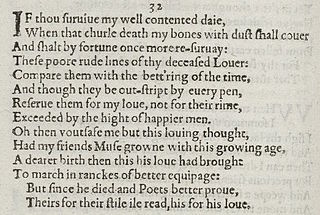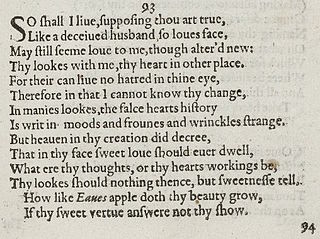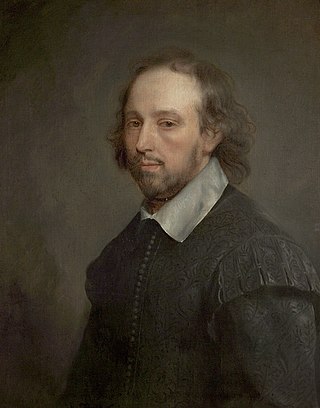
A sonnet is a poetic form that originated in the poetry composed at the Court of the Holy Roman Emperor Frederick II in the Sicilian city of Palermo. The 13th-century poet and notary Giacomo da Lentini is credited with the sonnet's invention, and the Sicilian School of poets who surrounded him then spread the form to the mainland. The earliest sonnets, however, no longer survive in the original Sicilian language, but only after being translated into Tuscan dialect.

George Meredith was an English novelist and poet of the Victorian era. At first his focus was poetry, influenced by John Keats among others, but he gradually established a reputation as a novelist. The Ordeal of Richard Feverel (1859) briefly scandalised Victorian literary circles. Of his later novels, the most enduring is The Egoist (1879), though in his lifetime his greatest success was Diana of the Crossways (1885). His novels were innovative in their attention to characters' psychology, and also took a close interest in social change. His style, in both poetry and prose, was noted for its syntactic complexity; Oscar Wilde likened it to "chaos illumined by brilliant flashes of lightning". He was an encourager of other novelists, as well as an influence on them; among those to benefit were Robert Louis Stevenson and George Gissing. He was nominated for the Nobel Prize in Literature seven times.

Sonnet 1 is one of 154 sonnets written by the English playwright and poet William Shakespeare. It is a procreation sonnet within the Fair Youth sequence.

Sonnet 60 is one of 154 sonnets written by the English playwright and poet William Shakespeare. It's a member of the Fair Youth sequence, in which the poet expresses his love towards a young beloved.

Sonnet 11 is one of 154 sonnets written by the English playwright and poet William Shakespeare. It is a procreation sonnet within the 126 sonnets of the Fair Youth sequence, a grouping of Shakespeare's sonnets addressed to an unknown young man. While the order in which the sonnets were composed is undetermined, Sonnet 11 was first published in a collection, the Quarto, alongside Shakespeare's other sonnets in 1609.
A sonnet sequence is a group of sonnets thematically unified to create a long work, although generally, unlike the stanza, each sonnet so connected can also be read as a meaningful separate unit.

Sonnet 21 is one of 154 sonnets written by the English playwright and poet William Shakespeare and is part of the "fair youth" sequence. Like Sonnet 130, it addresses the issue of truth in love, as the speaker asserts that his lines, while less extravagant than those of other poets, are more truthful. Contrary to most of Shakespeare's sonnets, Sonnet 21 is not addressed to any one person. There is no second person, no overt "you" or "thou" expressed in it.

Sonnet 32 is one of 154 sonnets written by the English playwright and poet William Shakespeare. It is a member of the Fair Youth sequence, in which the poet expresses his love towards a young man. The writer is reflecting on a future in which the young man will probably outlive him. The writer takes a melancholy tone, telling the young man to remember the writer not because of the strength of the sonnets, but because the love that has been shown to the young man far surpasses any love shown by another poet.

William Shakespeare's Sonnet 35 is part of the Fair Youth sequence, commonly agreed to be addressed to a young man; more narrowly, it is part of a sequence running from 33 to 42, in which the speaker considers a sin committed against him by the young man, which the speaker struggles to forgive.

Sonnet 36 is one of 154 Shakespeare's sonnets written by the English playwright and poet William Shakespeare. It's a member of the Fair Youth sequence, in which the speaker expresses his love towards a young man.

William Shakespeare's sonnet 116 was first published in 1609. Its structure and form are a typical example of the Shakespearean sonnet.

Sonnet 54 is one of 154 sonnets published in 1609 by the English playwright and poet William Shakespeare. It is considered one of the Fair Youth sequence. This sonnet is a continuation of the theme of inner substance versus outward show by noting the distinction between roses and canker blooms; only roses can preserve their inner essence by being distilled into perfume. The young man's essence or substance can be preserved by verse.

Sonnet 93 is one of 154 sonnets written by the English playwright and poet William Shakespeare. It is a member of the Fair Youth sequence, in which the poet expresses his love towards a young man.

Sonnet 67 is one of 154 sonnets written by the English playwright and poet William Shakespeare. It's a member of the Fair Youth sequence, in which the poet expresses his love towards a young man, and is a thematic continuation of Sonnet 66. In this poem, the speaker's anxiety about the social difference between him and his beloved takes the form of a criticism of courtly corruption. This sonnet was placed first in the pirated and mangled edition of 1640.

The sonnets of Petrarch and Shakespeare represent, in the history of this major poetic form, the two most significant developments in terms of technical consolidation—by renovating the inherited material—and artistic expressiveness—by covering a wide range of subjects in an equally wide range of tones. Both writers cemented the sonnet's enduring appeal by demonstrating its flexibility and lyrical potency through the exceptional quality of their poems.

Sonnet 71 is one of 154 sonnets written by the English playwright and poet William Shakespeare. It's a member of the Fair Youth sequence, in which the poet expresses his love towards a young man. It focuses on the speaker's aging and impending death in relation to his young lover.

Sonnet 72 is one of 154 sonnets published by the English playwright and poet William Shakespeare in 1609. It is one of the Fair Youth Sequence, which includes Sonnet 1 through Sonnet 126.
Sonnet 125 is one of 154 sonnets written by the English playwright and poet William Shakespeare. It is a member of the Fair Youth sequence, in which the poet expresses his love towards a young man.
Sonnet 101 is one of 154 sonnets written by the English playwright and poet William Shakespeare. It is a member of the Fair Youth sequence, in which the poet expresses his love towards a young man. The three other internal sequences include the procreation sonnets (1–17), the Rival Poet sequence (78–86) and the Dark Lady sequence (127–154). While the exact date of composition of Sonnet 101 is unknown, scholars generally agree that the group of Sonnets 61–103 was written mainly in the first half of the 1590s and was not revised before being published with the complete sequence of sonnets in the 1609 Quarto.
George Barlow was an English poet, who sometimes wrote under the pseudonym James Hinton.
















